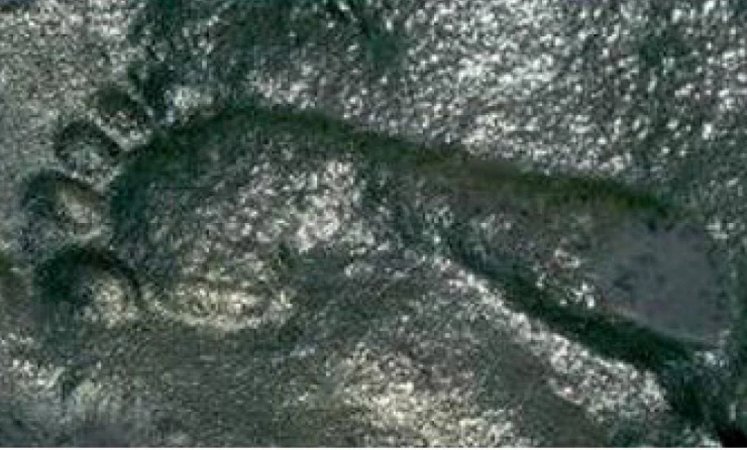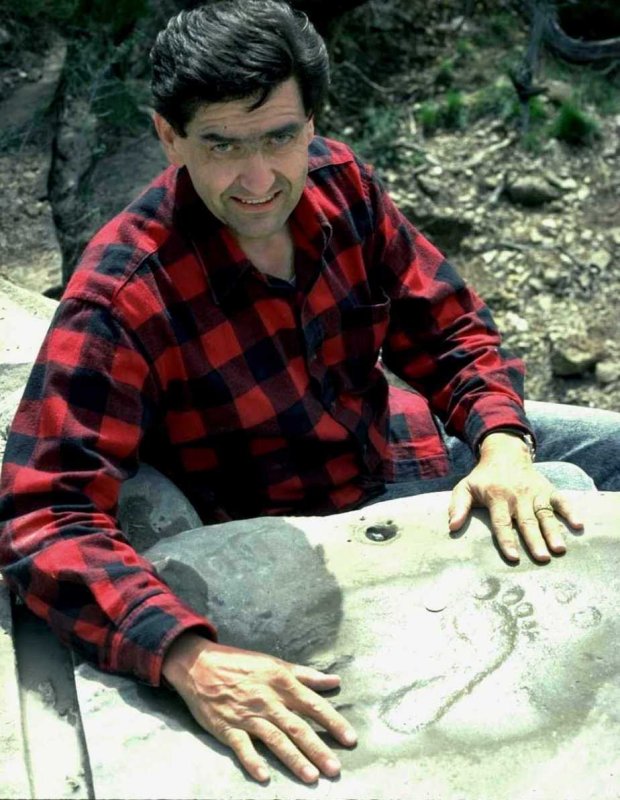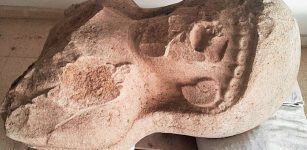Mystery Of The 290-Million-Year-Old Zapata Footprint In New Mexico
Jan Bartek - AncientPages.com - Fossilized footprints are often a subject of heated debates, especially if they are millions of years old and you cannot determine who made them.
In New Mexico, an extraordinary track is made in the mud. It's known as the Zapata footprint, and it is estimated "someone" made it about 290 million years ago.

The strange Zapata footprint is believed to be 290 million years old. Credit: Footprints in stone
Did human-like beings walk the Earth millions of years ago?
Is it a human footprint, or did a long-gone extinct animal make it? What did Earth look like 290 million years ago?
It was a time when the Earth's continents were fused in the supercontinent Pangea. Pangea broke into smaller continents in the Triassic period when dinosaurs first evolved. All plants and animals in those days would be unrecognizable to us.
The Zapata footprint was discovered many years ago by a hunter who informed his friend Don Shockey about the unusual find. Shockey, who knew about archaeology and anthropology, decided to investigate the footprint in the wilderness of New Mexico. He gathered a science team consisting of several experts. Two of the team's participants were Dr. Don Patton and Dr. Carl Baugh.

Stunning View Of What Supercontinent Pangea Looks Like Mapped With Modern Borders - Read More
Dr. Patton was an experienced geologist who had worked in several countries investigating fossils and participated in dinosaur excavations in Colorado, Texas, Wyoming, and Canada.
Dr. Baugh is the discoverer and excavation director of sixteen dinosaurs, including Acrocanthosaurus in Texas and Diplodocus in Colorado.
With such experienced science members, there should be an excellent chance to determine what kind of creature had left the footprint. The investigations should have been easy, but it wasn't due to several obstacles researchers encountered.
Soon after the science team obtained a mining permit to excavate in the area where the track was located, a local armed landowner threatened them for trespassing private land, claiming they were on this private land.

Examination of the Zapata fooprint. Credit: Footprints in stone
Shockey and his team showed the angry man their permission to excavate at the site and explained this was the BLM (Bureau of Land Management) property. Unfortunately, the landowner had a different opinion and told them to leave immediately. The team managed to take some photographs, but researchers were forced to interrupt the documentation, and they left the place in a hurry.
From an archaeological point of view, this was a tragedy because the hunter who had originally reported the discovery "had also reported that he had seen several other human footprints in the rock around the same area and showed Dr. Patton several photographs to validate his story." 1
According to Dr. Patton, the Zapata footprint is exceptionally shallow, making it very difficult to photograph.
So, who made the Zapata footprint? A majority will say humans did not exist millions of years ago. Could the Zapata footprint belong to a bipedal dinosaur? Maybe it can, but as we said at the beginning of this article, this happened during the age of Pangea, and scientists have concluded dinosaurs inhabited the world for some 160 million years. It means the Zapata footprint predates the dinosaurs.
Strange tracks in rocks have been found before, and they often pose a challenge to our historical timelines.
Some years ago, scientists discovered a set of controversial human-like footprints on Crete. These tracks are now putting the theory of human evolution to the test.
"The footprints are about 5.7 million years old from Trachilos in western Crete and have an unmistakably human-like form. It is especially true of the toes. The big toe is similar to our own in shape, size, and position. It is also associated with a distinct 'ball' on the sole, which is never present in apes." 2
Is it possible humans appeared much earlier than previously thought, or did unknown human-like beings leave behind footprints scientists cannot identify?
Written by Jan Bartek - AncientPages.com Staff Writer
Updated on April 4, 2023
Copyright © AncientPages.com All rights reserved. This material may not be published, broadcast, rewritten or redistributed in whole or part without the express written permission of AncientPages.com
Expand for referencesMore From Ancient Pages
-
 Sinuses Prevented Prehistoric Crocodile Relatives From Deep Diving
Evolution | Nov 7, 2024
Sinuses Prevented Prehistoric Crocodile Relatives From Deep Diving
Evolution | Nov 7, 2024 -
 Necropolis of Porta Nola, Pompeii – new discoveries
Civilizations | Aug 30, 2015
Necropolis of Porta Nola, Pompeii – new discoveries
Civilizations | Aug 30, 2015 -
 Largest And Most Complete Ancient Egyptian Workshops Found In Saqqara
Archaeology | May 28, 2023
Largest And Most Complete Ancient Egyptian Workshops Found In Saqqara
Archaeology | May 28, 2023 -
 Freemasons Secrets – American Democracy Is Part Of An Ancient Universal Plan – Egyptian Temple And Legendary Expedition Hold The Clues – Part 2
Civilizations | Jul 13, 2018
Freemasons Secrets – American Democracy Is Part Of An Ancient Universal Plan – Egyptian Temple And Legendary Expedition Hold The Clues – Part 2
Civilizations | Jul 13, 2018 -
 Giant Ancient Minoan Axes Used For Unknown Purposes
Artifacts | Nov 27, 2017
Giant Ancient Minoan Axes Used For Unknown Purposes
Artifacts | Nov 27, 2017 -
 Time Capsule – Best Preserved 3,000-Year-Old Dwelling Ever Found In Britain
Archaeology | Jan 12, 2016
Time Capsule – Best Preserved 3,000-Year-Old Dwelling Ever Found In Britain
Archaeology | Jan 12, 2016 -
 Hundreds Of Thousands Of Sumerian Artifacts Have Been Stolen From Iraq’s Museums And Archaeological Sites
Artifacts | Dec 7, 2020
Hundreds Of Thousands Of Sumerian Artifacts Have Been Stolen From Iraq’s Museums And Archaeological Sites
Artifacts | Dec 7, 2020 -
 Megalith Tombs Were Family Graves In Stone Age Europe
Archaeology | Apr 15, 2019
Megalith Tombs Were Family Graves In Stone Age Europe
Archaeology | Apr 15, 2019 -
 On This Day In History: Siege Of Belgrade – Hungarian Battle Victory – On July 4,1456
News | Jul 4, 2016
On This Day In History: Siege Of Belgrade – Hungarian Battle Victory – On July 4,1456
News | Jul 4, 2016 -
 Rare Phoenician Necropolis Discovered In Andalucia, Spain Is Extraordinary, Scientists Say
Archaeology | May 2, 2022
Rare Phoenician Necropolis Discovered In Andalucia, Spain Is Extraordinary, Scientists Say
Archaeology | May 2, 2022 -
 Mysterious Undeciphered Carvings And Script On Stela Of Montoro
Archaeology | Aug 14, 2017
Mysterious Undeciphered Carvings And Script On Stela Of Montoro
Archaeology | Aug 14, 2017 -
 Irkalla – Underworld With No Return Ruled By Ereshkigal, Granddaughter Of Enlil And Sister Of Inanna
Featured Stories | Oct 20, 2021
Irkalla – Underworld With No Return Ruled By Ereshkigal, Granddaughter Of Enlil And Sister Of Inanna
Featured Stories | Oct 20, 2021 -
 1.5-Million-Year-Old Footprints Of Two Different Species Of Human Ancestors Found At The Same Spot
Human Beginnings | Nov 29, 2024
1.5-Million-Year-Old Footprints Of Two Different Species Of Human Ancestors Found At The Same Spot
Human Beginnings | Nov 29, 2024 -
 On This Day In History: Black Death Arrived In Britain – On June 24, 1348
News | Jun 24, 2016
On This Day In History: Black Death Arrived In Britain – On June 24, 1348
News | Jun 24, 2016 -
 What Fossils Reveal About Hybridization Of Early Humans – History Of Humankind Is More Complex Than Previously Thought
Archaeology | Sep 6, 2022
What Fossils Reveal About Hybridization Of Early Humans – History Of Humankind Is More Complex Than Previously Thought
Archaeology | Sep 6, 2022 -
 Horrifying Flying Head That Terrorized The Iroquois
Featured Stories | Sep 17, 2019
Horrifying Flying Head That Terrorized The Iroquois
Featured Stories | Sep 17, 2019 -
 3,000-Year-Old Female Statue Unearthed In Turkey
Archaeology | Aug 11, 2017
3,000-Year-Old Female Statue Unearthed In Turkey
Archaeology | Aug 11, 2017 -
 Amazing Ancient One-Stroke Dragon Art Tradition – Painting Dragons With A Single Brush Stroke
Ancient Traditions And Customs | Apr 29, 2021
Amazing Ancient One-Stroke Dragon Art Tradition – Painting Dragons With A Single Brush Stroke
Ancient Traditions And Customs | Apr 29, 2021 -
 Chickens Were Introduced To Britain, Mainland Europe, And Northern Africa Later Than Previously Thought
Archaeology | Jun 13, 2022
Chickens Were Introduced To Britain, Mainland Europe, And Northern Africa Later Than Previously Thought
Archaeology | Jun 13, 2022 -
 On This Day In History: King Henry VII’s Coronation Was Held – On Oct 30, 1485
News | Oct 30, 2017
On This Day In History: King Henry VII’s Coronation Was Held – On Oct 30, 1485
News | Oct 30, 2017
